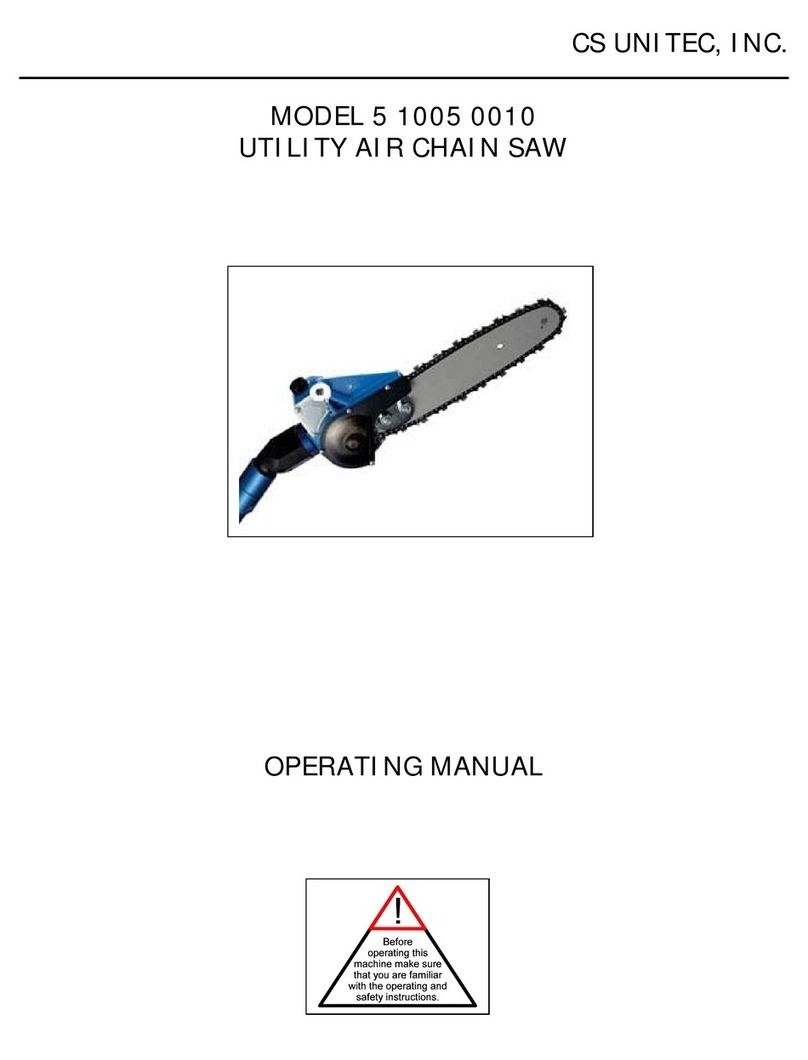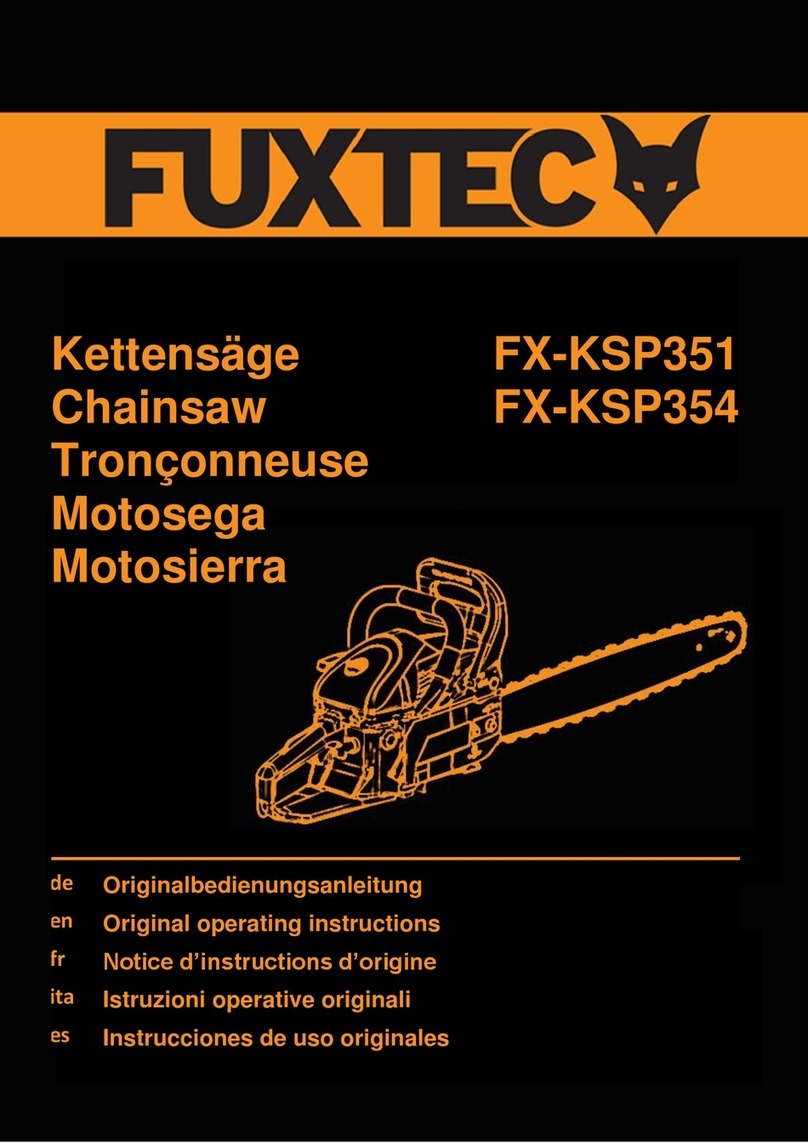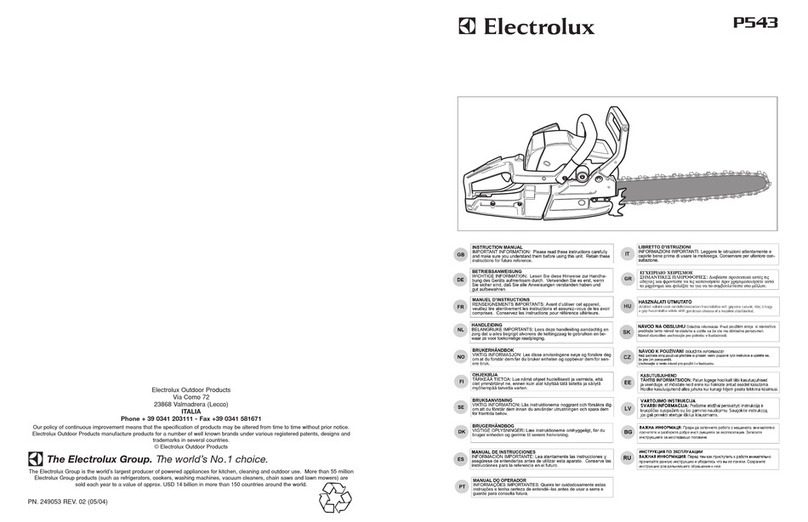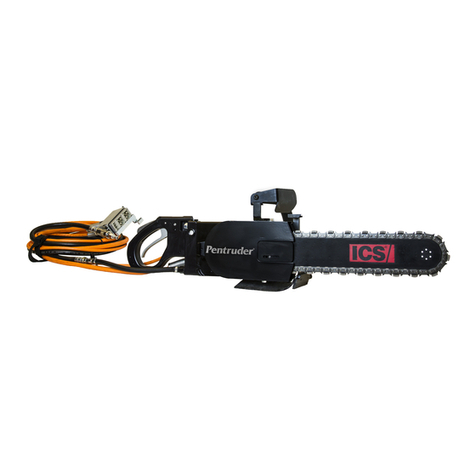CS Unitec CS536664 User manual

Model # CS536664
OPERATOR’S MANUAL
CS Unitec
22 Harbor Ave
Norwalk CT 06850 USA
(203) 853-9522
toll free: (800)-700-5919
fax: (203-)853-9921
e mail: info@csunitec.com
www.csunitec.com
p/n 71702 rev June 2016

OPERATOR’S MANUAL
2
INTRODUCTION
This is a professional tool and is solely intended for use by trained and
experienced operators.
The CS536664 saw is designed to cut concrete, stone and masonry when
used with the appropriate diamond chain. Other materials including ductile
iron, cast iron or PVC Pipe require the use of Utility Chain.
To get the maximum benefit from your saw, and ensure maximum safety,
be sure to read this manual thoroughly, and periodically review safety
instructions.
SYMBOLS & LABELS 3
SAFETY 4 - 6
TECHNICAL SPECIFICATIONS 7
SET-UP 8 - 13
OPERATION 14 - 19
TROUBLESHOOTING 20
MAINTENANCE 21 - 22
REFERENCE 23
TABLE OF CONTENTS

OPERATOR’S MANUAL
3
To get the maximum benefi t from your saw
and ensure maximum safety, be sure to
read and understand this manual
thoroughly and follow the safety
instructions provided
Always use:
• Protective helmet
• Ear protection
• Protective glasses or full face
protection
Wear hand protection
�WARNING
• Do NOT operate saw without side cover.
• Do NOT operate saw without baffle drain.
• Do NOT use this saw cover on any other saw model.
• Failure to observe these precautions can result in serious injury.
SYMBOLS & LABELS
�WARNING
• Do not exceed 90psi (6 bar) air
pressure or 124 cfm (3.5m3/min) air
volume
• Do NOT insert tool into slot narrower
than chain.
• Do NOT operate tool without solid
footing and firm hand grip.
SAFETY RULES
To get the maximum bene t from your saw, and ensure maximum safety, be
sure to read this manual thoroughly and follow the safety instructions provided.
EXPLANATION OF WARNING LEVELS
IMPORTANT
Indicates a hazard with a medium level of risk which, if not avoided, could result
in death or serious injury.
Indicates a hazard with a low level of risk which, if not avoided, could result in
minor or moderate injury.
Indicates a potential situation exists which, if not avoided, may result in damage
to your saw or property.
Indicates a hazard with a high level of risk which, if not avoided, will result in
death or serious injury.
WARNING
CAUTION
DANGER

OPERATOR’S MANUAL
4
THE FOLLOWING WARNING SYMBOL APPLIES TO ALL THE ITEMS LISTED
ON THIS PAGE
Note: Chain breakage can result in high-speed ejection of parts, which
can result in death or serious personal injury to operators or bystanders.
The items listed immediately below are critical to minimizing the risk of
chain breakage and injury.
• DO NOT operate the saw with damaged, modifi ed or missing
components shown below.
• Side cover
• Mud fl ap
• Rear hand guard
• Mud fl ap bracket (chain catcher)
• Trigger interlock
• DO NOT exceed 90 psi (6 bar) and 124 cfm (3.5 m3/min) operating
pressure and volume.
• DO NOT insert the diamond chain saw into a slot narrower than the chain
segments.
Rapid pushback might occur.
NOTE: Most diamond chain segments are .225 inches (5.72 mm) wide.
• NEVER run a diamond chain saw upside-down.
Concrete debris can fl y back into the operator’s face.
• NEVER cut ductile iron pipe with concrete chain.
Segment loss or chain breakage may occur.
• NEVER operate the saw with a saw chain or saw bar designed to cut
wood.
Using wood cutting saw chain on the saw could result in severe
injuries to operator and bystanders! Use ONLY the cutting attachments
speci ed in this manual on this saw.
SAFETY
WARNING
WARNING
Indicates a hazard with a medium level of risk
which, if not avoided, could result in death or
serious injury.

OPERATOR’S MANUAL
5
SAFETY
THE FOLLOWING WARNING SYMBOL APPLIES TO ALL THE ITEMS LISTED
ON THIS PAGE
This saw can generate hazardous dust and vapors.
Determine the nature of the material you are going to cut before
proceeding with the job. Be especially aware of cutting materials containing
silica and asbestos as inhaling dust can result in respiratory disease. Be sure
to use appropriate respiratory protection designed to lter out microscopic
particles. Be sure to use adequate water pressure.
Over-exposure to vibration can lead to circulatory and/or nerve damage to
the extremities, especially in cold temperatures (Reynaud’s Disease).
If you experience tingling, numbness, pain or changes in skin color, particularly
in your ngers, hands or wrists, stop using the saw immediately. If the
problem persists, seek medical attention.
WARNING
WARNING
Indicates a hazard with a medium level of risk
which, if not avoided, could result in death or
serious injury.

OPERATOR’S MANUAL
6
• Always disconnect the air supply and relieve pressure from supply lines
before performing maintenance on the saw.
• Diamond chains and guidebar require a minimum water pressure of 20 psi
(1.4 bar). Insu cient water supply may result in excessive wear to the
guidebar or diamond chain, which can lead to loss of strength and diamond
chain breakage and damage the bar.
• When operating a compressor with greater than 90 psi (6 bar) it is
recommended to use a “service unit with pressure regulator” in line to
prevent over speeding the saw.
GENERAL SAFETY PRECAUTIONS
• Always wear protective clothing, including a hard hat, eye protection, hearing
protection and gloves.
• Avoid loose clothing.
• Perform safety checks before starting each day.
• Always operate tool with solid footing and handgrip.
• Remove or control slurry to prevent yourself or others from slipping while
cutting.
• Always work in a cleared area.
• Be sure there are no obstructions (plumbing, electrical conduit, air ducts).
• Set up a well-marked safety zone with a roped boundary and clear signs to
keep bystanders at least 20 ft (5m) away.
• Breathing exhaust fumes is dangerous. Provide ventilation in closed areas.
• To avoid electrocution, check for live electrical wiring near cutting area.
THE FOLLOWING WARNING SYMBOL APPLIES TO ALL THE ITEMS LISTED
ON THIS PAGE
SAFETY
CAUTION
CAUTION
Indicates a hazard with a low level of risk which,
if not avoided, could result in minor or moderate
injury.

OPERATOR’S MANUAL
7
TECHNICAL SPECIFICATIONS
Weight without bar and chain 29 lbs (13 kg)
Length 20 in (58.5 cm)
Height 10.5 in (26.5 cm)
Width 12 in (30.5cm)
Air Motor Power 6.5 Hp (5 Kw)
Air Supply Requirements (maximum) 90psi (6 bar)
124 cfm (3.5 m3/min)
Motor lubrication requirements Resin and acid-free
SAE 5 W to SAE 10 W oil
Water Pressure Requirements Minimum: 20 psi (1.4 bar)
Water Flow Requirements 1 gpm (4 lpm) minimum
Operating Speed 5,700 rpm (average free running)
4,900 sfm (average free running chain)
Vibration ahv, eq Concrete Cutting (2) Front handle: 5.09 m/s2 (K=0.2 m/s2)
Rear handle: 5.07 m/s2 (K=0.2 m/s2)
Vibration ahv, eq PowerGrit Cutting (2) Front handle: 4.58 m/s2 (K=0.2 m/s2)
Rear handle: 4.43 m/s2 (K=0.2 m/s2)
Guaranteed Sound Power Level Lwa (1) 113 dB(A); (Kwa=0.5 dB(A))
• When operating a compressor with pressure greater than 90 psi (6 bar) it is
recommended to use a “service unit with pressure regulator” in the line to prevent over
speeding the saw.
•Always use an in-line oiler or air pac to provide continuous lubrication to the air motor. This will
increase the life of the saw and reduce down time.
(1) Measured in accordance with ANSI S12.51-2012/ISO3741:2010
(2) Measured in accordance with ISO5349-1:2001 and ISO22867:2011

OPERATOR’S MANUAL
8
STEP 1
Loosen the side cover nuts and remove
the side cover and bar clamp plate.
STEP 2
Place the bar onto the studs and the chain
adjustment pin.
SET-UP

OPERATOR’S MANUAL
9
STEP 3
Turn the chain-tensioning screw
counterclockwise until the bar comes into
contact with the drive sprocket.
STEP 4
Mount the chain on the bar starting at
the drive sprocket & continue over the
bar nose.
SET-UP
start here

OPERATOR’S MANUAL
10
STEP 5
Make sure all of the drive links are inside
the bar groove, then pre-tension the chain
by turning the tensioning screw clockwise.
SET-UP
STEP 6
Install the bar clamp plate over the
bar studs in proper orientation. "Front" is
marked on the plate.

OPERATOR’S MANUAL
11
STEP 7
Install the side cover over the bar studs
and install side cover nuts. Finger
tighten only.
STEP 8
Tension the chain properly. Do not over
tension the diamond chain. Loss of power
will result.
SET-UP

OPERATOR’S MANUAL
12
CORRECT CHAIN TENSION
All chains have a tendency to stretch
when used. Diamond chains stretch
more than wood cutting chains
because of the abrasive materials
they are cutting.
If the chain is too tight, more power
goes into turning the chain rather
than into the cut. In extreme
over-tightened cases, the saw
may not be able to turn the chain
at all. In addition, damage can occur
to the bar nose and premature
stretch may occur.
CHAIN TOO LOOSE
If the chain is too loose, it could come
off the bar, or it will allow the drive
sprocket to spin without turning the
chain, which can damage drive links.
When a chain stretches to a point
where the drive links are hanging
approximately 1/2 in (12 mm) to 3/4
in (18 mm) below the bar, it is time to
tension the chain.
CORRECT CHAIN TENSION
CHAIN TOO TIGHT CHAIN TOO LOOSE
CHAIN TOO TIGHT CHAIN TOO LOOSE
SET-UP
IMPORTANT
CAUTION
CAUTION
CAUTION
CAUTION

OPERATOR’S MANUAL
13
STEP 9
Lift up on the nose of the bar and firmly
tighten the side cover nuts. Be sure
the side cover nuts are tightened to
approximately 20 ft-lbs (27 Nm).
SET-UP

OPERATOR’S MANUAL
14
OPERATION
PRE-CUT CHECKLIST
ADDITIONAL TENSIONING TIPS:
1. To reduce chain stretch and tensioning downtime, use 20 psi (1.5 bar) or
greater water pressure.
2. Oil the chain at the end of the day to prevent rust but be careful not to over
tension in this condition.
3. When pulling the chain around the bar by hand, be sure to wear gloves. The
bar rails can be very sharp. Grab only the diamond segments to pull the
chain.
4. Always pull the chain away from the WallWalker®. The point of the
WallWalker can also be very sharp.
PROPER CHAIN TENSION
Concrete cutting chainsaws operate with looser chain tension than wood
chainsaws. It is common, especially on gas powered, concrete cutting
chainsaws to have the drive links hang completely out of the bar. Concrete
cutting chainsaws require water for cooling and flushing the cut. Rotating the
chain completely around the bar freely by hand will let you know you have the
chain properly tensioned.
Before tensioning chain, always turn the compressor off and relieve system
pressure before disconnecting from the compressor.
To maximize the life of the cutting system, ensure that proper chain
tension is maintained.
If tension is too tight, it will lead to excessive chain stretch, and a lot of the
saw’s power will be used to overcome friction. In severe cases the chain may
not turn at all and can lead to chain breakage. If the tension is set too loose,
the chain could be thrown off of the bar, or allow the sprocket to turn with out
turning the chain, which will damage the drive links.
WARNING
WARNING
CAUTION
CAUTION

OPERATOR’S MANUAL
15
PRE-CUT CHECKLIST, CONT.
• Adequate Water Supply and Pressure:
Minimum Flow: 1 gpm (4 lpm)
Minimum Water Pressure: 20 psi (1.4 bar)
Checking for water pressure without a pressure gauge: With the compressor
o, attach water hose to the saw water connection. Pull the chain o to one
side of the bar and turn on the water valve. If there is a minimum of 20 psi,
water should spray 1 - 3 ft (.3 to 1 m) from the bar.
• Proper Air Supply to the Saw:
Maximum PSI: 90 (6 bar)
Maximum CFM: 124 cfm (3.5 M3/min)
Insure the air supply line is clear before connecting it to the saw. Dirt and
water separators are recommended to prevent rust and condensation from
forming in the air lines.
• Motor Lubricator: (Not Included)
Always use an in-line oiler to provide continuous lubrication to the air
motor. The air lubricator or combination lubricator/air drier must be placed 6
to 12 feet (2 - 4 meters) from the tool. This will increase the life of the saw and
reduce down time.
Check oil level, when necessary; ll with resin and acid-free SAE 5 W to
SAE 10 W oil.
In winter or when using very moist air, use antifreeze lubricant, such as “Prol-
ube ATL/AF”, “Killfrost” “BP Energol AX10” or “Kompranol”
OPERATION

OPERATOR’S MANUAL
16
PLANNING THE CUT
• Select the proper chain for the material being cut.
• Outline the cut with a permanent marker for a visual cutting guide.
• Avoid pinching the bar and chain. Always cut the bottom of an opening rst,
then top, and then the sides. Save the easiest cut for last.
OPERATION
If cutting pipe with PowerGrit® be sure the cut line stays open by providing
proper pipe support. Also check for neighboring utilities or obstructions.
Concrete is very heavy, 1 cubic foot (30 cubic cm) weighs 150 lbs (68 kg). Be
sure to cut so that concrete cannot fall and injure operator or bystanders.
Check for live electrical wiring near the cutting area or in the concrete to
avoid electrocution which can result in death or serious personal injury.
WARNING
WARNING

OPERATOR’S MANUAL
17
OPERATION
• When cutting reinforced concrete, be sure you are always cutting
concrete as well as rebar. This will prevent the segments from glazing
over and keep the diamonds exposed. Also, expect less chain life when
cutting concrete with heavy rebar.
• When replacing a chain, fl ip the guidebar over and dress your
guidebar rails to maintain straight cuts. Guidebar rails can be dressed
with a fl at le or belt sander.
• Note: The normal life of a guidebar is 2 to 3 chains. However, heavy
rebar can shorten guidebar life too.
• When using a new chain, cutting speed can be increased by
“opening up the diamonds”. Make a few plunge cuts in an abrasive
material such as a cinder block.
Wear gloves when handling the bar and chain. Over time, these components
can develop sharp edges and cause cuts.
CAUTION
CAUTION

OPERATOR’S MANUAL
18
OPERATION
OPERATING THE DIAMOND CHAINSAW IN CONCRETE
• When cutting into concrete, plunge cut instead of starting at the top
of the wall. This will reduce chatter, extend diamond life, create a
straighter cut and more quickly enable the use of the Wallwalker®.
• Always operate a diamond saw at full throttle. If too much force is
applied, the saw will lug or stall and the chain will not have enough
speed to cut e ectively. If too little force is applied, the diamonds will
skid and glaze over.
• For the straightest cuts use the “step cut” method. First score the
entire cut line with the nose of the bar approximately ½ inch (12 mm)
to 1 inch (25 mm) deep. Next, deepen the cut by about 2 inches (50
mm). This groove will help guide the bar for a straight cut.
Then plunge all the way through and complete the cut using the
Wallwalker®.
• Use the Wallwalker to cut e ciently and reduce operator fatigue. The
Wallwalker when extended is a fulcrum that converts inward force to
downward force and will develop a 4-to-1 mechanical advantage. To
use correctly, plunge into the wall and simply engage the point of the
Wallwalker into the cut and push straight in. The Wallwalker will force
the saw to feed down.

OPERATOR’S MANUAL
19
SYSTEM CLEAN-UP
1. Run saw, with water on, for 15 seconds out of cut to fl ush slurry and debris
from chain, bar and drive sprocket.
2. Wash concrete slurry from saw body.
3. Remove bar and chain. Flush out chain tensioner assembly location with
high water pressure and lube with grease.
4. Clean all air ttings on saw and compressor.
5. When done cleaning saw, spray entire saw body, chain, bar, and drive
sprocket with a lightweight penetrating oil. This will minimize rust and
reduce slurry build up on saw assembly.
OPERATION

OPERATOR’S MANUAL
20
• SLOW CHAIN SPEED - Be sure the compressor is providing the correct
air pressure at the saw (90 psi = 6 bar) and cubic feet per minute
(124 cfm = 3.5 m3/min). Chain is installed too tight. Refer to tension on
page 11. Low oil or no oil is getting to the motor. Make sure the drops per
minute (DPM) is set between 10 & 15.
• CONCRETE CHAIN - POOR CUTTING PERFORMANCE - Diamonds may
be “glazed over”. Make a few plunge cuts in an abrasive material such as a
cinder block to expose the diamonds.
• UTILITY CHAIN - POOR CUTTING PERFORMANCE - PowerGrit® chain is
worn out. Make sure the diamonds are intact and exposed. DO NOT use
PowerGrit for cutting steel.
• PREMATURE CHAIN STRETCH - Not enough water pressure, the
minimum water pressure is 20 psi (1.4 bar). Insucient water supply will
result in excessive wear on the chain, which can lead to loss of strength
and chain breakage. Cutting with the guidebar nose buried in the cut, in
sand, gravel, pipe or using with improper chain tension will all contribute to
increased chain stretch.
NOTE: This applies to PowerGrit chains also.
• CHAIN TENSIONER BREAKAGE - Side cover nuts are not tight enough, or
tensioning was attempted with side cover nuts already fully tightened.
• WATER NOT FLOWING - Water hose is kinked, blockage in guidebar
water ports, or supply is not turned on.
• MOTOR DOES NOT START
• Insucient air supply. Check compressor and air hose, valves, and air
inlet screen for blockage.
• Chain tension is too tight, loosen chain tension.
• Iced exhaust. wait until ice thaws, then use anti-freeze lubricant
• Vanes sticky. Apply lubricant directly to saw air inlet and blow motor
clear. Repeat if necessary. See maintenance instructions
TROUBLESHOOTING
Further questions?
Call 800.700.5919 or visit our website at: csunitec.com
Table of contents
Other CS Unitec Chainsaw manuals
Popular Chainsaw manuals by other brands
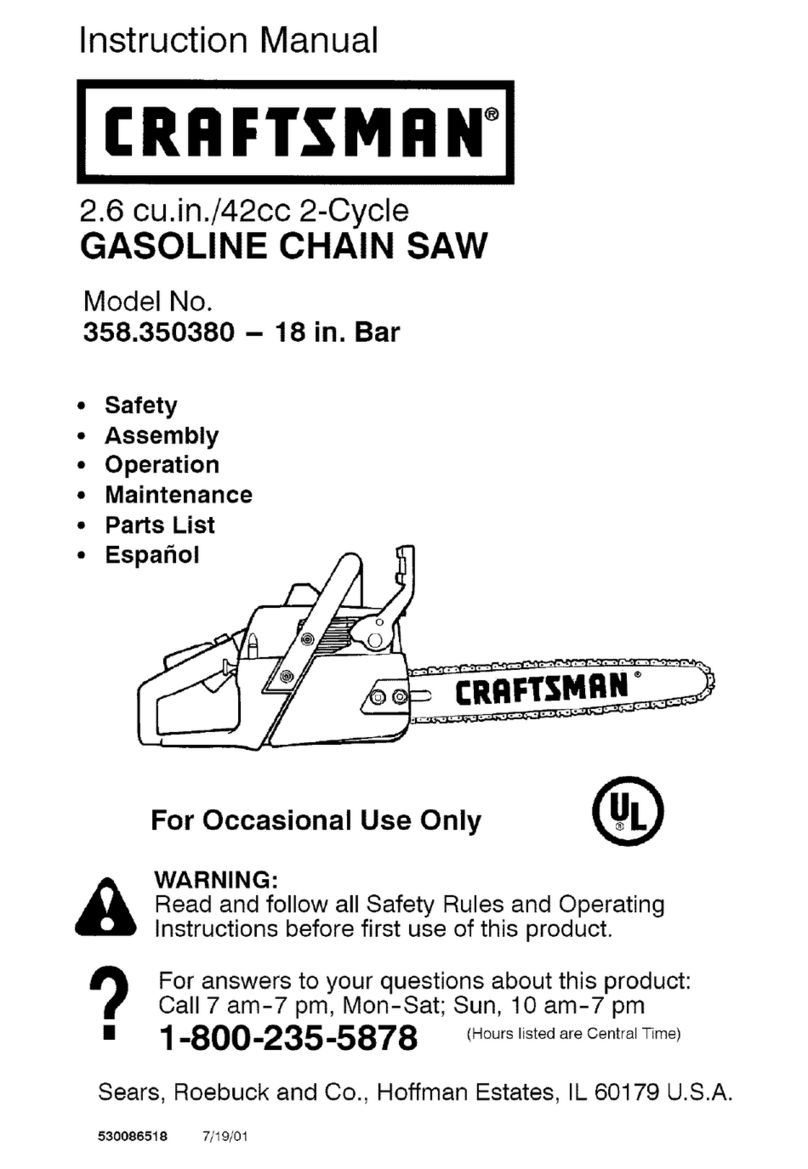
Craftsman
Craftsman 358.350380 instruction manual

Shindaiwa
Shindaiwa 600sx Operator's manual
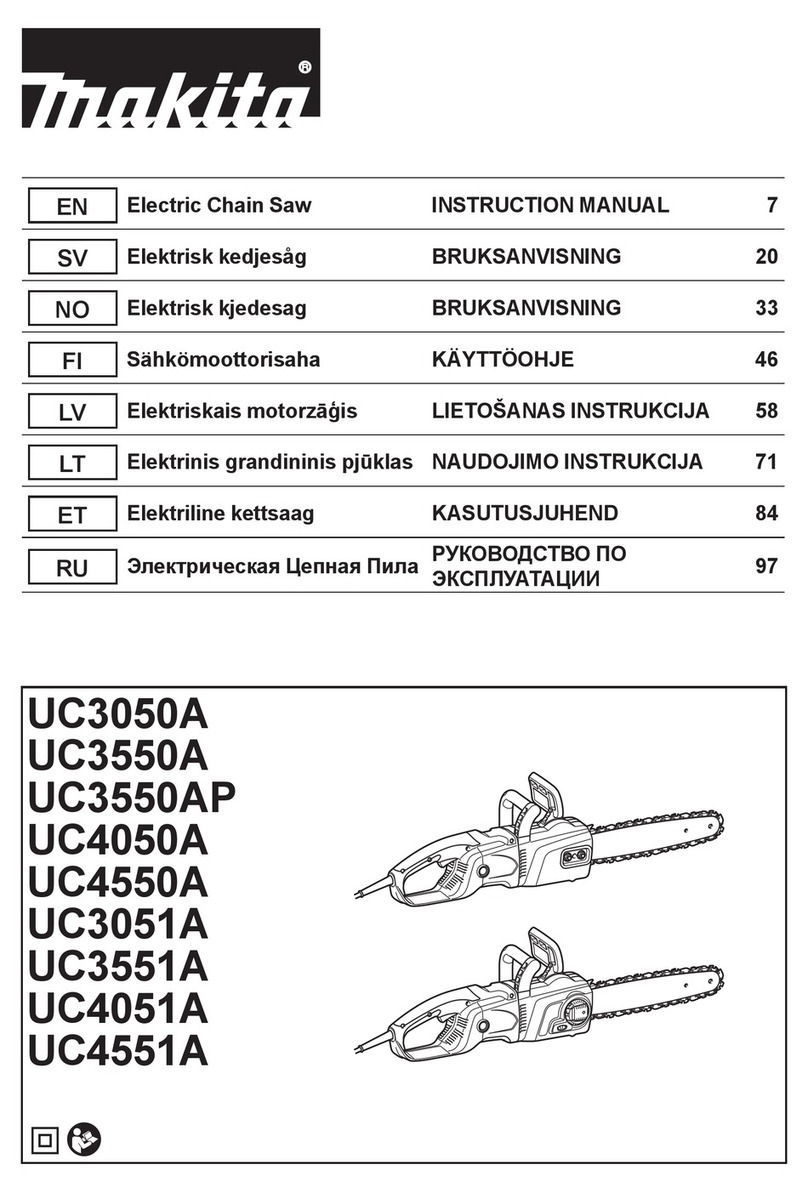
Makita
Makita UC3050A instruction manual

Ausonia
Ausonia work it saw AGROSIMEX 31705 user manual

GGP ITALY SPA
GGP ITALY SPA Electric Chain-saw Operator's manual

Gude
Gude KS 401 BW Translation of the original instructions
